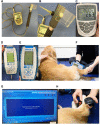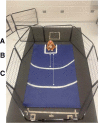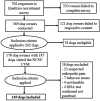Pain sensitivity differs between dog breeds but not in the way veterinarians believe
- PMID: 37435196
- PMCID: PMC10332458
- DOI: 10.3389/fpain.2023.1165340
Pain sensitivity differs between dog breeds but not in the way veterinarians believe
Abstract
Background: Veterinarians hold distinct breed-specific pain sensitivity beliefs that differ from the general public but are highly consistent with one another. This is remarkable as there is no current scientific evidence for biological differences in pain sensitivity across dog breeds. Therefore, the present study evaluated whether pain sensitivity thresholds differ across a set of dog breeds and, if so, whether veterinarians' pain sensitivity ratings explain these differences or whether these ratings are attributed to behavioral characteristics.
Methods: Pain sensitivity thresholds [using quantitative sensory testing (QST) methods] and canine behaviors (using owner questionnaires and emotional reactivity tests) were prospectively measured across selected dog breeds. Adult, healthy dogs from 10 dog breeds/breed types were recruited, representing breeds subjectively rated by veterinarians as high (chihuahua, German shepherd, Maltese, Siberian husky), average (border collie, Boston terrier, Jack Russell terrier), or low (golden retriever, pitbull, Labrador retriever) pain sensitivity. A final sample of 149 dogs was included in statistical analyses.
Results: Veterinarians' pain sensitivity ratings provided a minimal explanation for pain sensitivity thresholds measured using QST in dogs; however, dog breeds did differ in their pain sensitivity thresholds across the QST methods evaluated. Breed differences were observed for some aspects of emotional reactivity tests; however, these behavioral differences did not explain the differences in pain sensitivity thresholds found. Veterinarians' pain sensitivity ratings were positively associated with dog approach scores for the disgruntled stranger test suggesting that the way dogs greet strangers may be a factor influencing veterinarians' ratings of pain sensitivity across dog breeds.
Conclusions and clinical relevance: Overall, these findings highlight a need to investigate biological mechanisms that may explain breed differences in pain sensitivity because this may inform pain management recommendations. Further, future research should focus on when and how these breed-specific pain sensitivity beliefs developed in veterinarians, as veterinarians' beliefs could impact the recognition and treatment of pain for canine patients.
Keywords: affective states; animal welfare; attitudes; canine behavior; healthcare provider beliefs; perceptions of patient pain; quantitative sensory testing; stereotypes.
© 2023 Caddiell, Cunningham, White, Lascelles and Gruen.
Conflict of interest statement
The authors declare that the research was conducted in the absence of any commercial or financial relationships that could be construed as a potential conflict of interest.
Figures










Similar articles
-
Frequency and predisposing factors for canine otitis externa in the UK - a primary veterinary care epidemiological view.Canine Med Genet. 2021 Sep 7;8(1):7. doi: 10.1186/s40575-021-00106-1. Canine Med Genet. 2021. PMID: 34488894 Free PMC article.
-
Veterinary education and experience shape beliefs about dog breeds Part 1: Pain sensitivity.Sci Rep. 2023 Aug 24;13(1):13846. doi: 10.1038/s41598-023-40671-y. Sci Rep. 2023. PMID: 37620361 Free PMC article.
-
Small Animal Veterinarians' Perceptions, Experiences, and Views of Common Dog Breeds, Dog Aggression, and Breed-Specific Laws in the United States.Int J Environ Res Public Health. 2019 Oct 23;16(21):4081. doi: 10.3390/ijerph16214081. Int J Environ Res Public Health. 2019. PMID: 31652882 Free PMC article.
-
Dog Bites in the United States from 1971 to 2018: A Systematic Review of the Peer-Reviewed Literature.Plast Reconstr Surg. 2020 Nov;146(5):1166-1176. doi: 10.1097/PRS.0000000000007253. Plast Reconstr Surg. 2020. PMID: 33136964
-
Understanding farmers' and veterinarians' behavior in relation to antimicrobial use and resistance in dairy cattle: A systematic review.J Dairy Sci. 2021 Apr;104(4):4584-4603. doi: 10.3168/jds.2020-19614. Epub 2021 Feb 19. J Dairy Sci. 2021. PMID: 33612225
Cited by
-
Agreement of Pain Assessment Using the Short Form of the Canine Glasgow Composite Measure Pain Scale between Veterinary Students, Veterinary Nurses, Veterinary Surgeons, and ECVAA-Diplomates.Animals (Basel). 2024 Aug 8;14(16):2310. doi: 10.3390/ani14162310. Animals (Basel). 2024. PMID: 39199844 Free PMC article.
-
Behavioural differences and similarities between dog breeds: proposing an ecologically valid approach for canine behavioural research.Biol Rev Camb Philos Soc. 2025 Feb;100(1):68-84. doi: 10.1111/brv.13128. Epub 2024 Aug 5. Biol Rev Camb Philos Soc. 2025. PMID: 39101379 Free PMC article. Review.
-
Transitional lumbosacral vertebrae in black Norwegian elkhound and Brittany dogs: Clinical findings and its association with degenerative lumbosacral stenosis.Acta Vet Scand. 2025 Feb 12;67(1):10. doi: 10.1186/s13028-025-00797-7. Acta Vet Scand. 2025. PMID: 39939978 Free PMC article.
-
Methods of behavioral testing in dogs: a scoping review and analysis of test stimuli.Front Vet Sci. 2024 Oct 16;11:1455574. doi: 10.3389/fvets.2024.1455574. eCollection 2024. Front Vet Sci. 2024. PMID: 39479206 Free PMC article.
References
LinkOut - more resources
Full Text Sources

